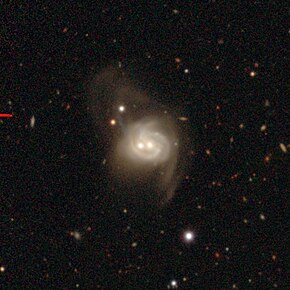NGC 3758
| NGC 3758 | |
|---|---|
 DECam image of NGC 3758 | |
| Observation data (J2000 epoch) | |
| Constellation | Leo |
| Right ascension | 11h 36m 29.10s |
| Declination | +21d 35m 46.0s |
| Redshift | 0.029771 |
| Heliocentric radial velocity | 8,909 km/s |
| Distance | 447 Mly (137 Mpc) |
| Apparent magnitude (V) | 14.3 |
| Characteristics | |
| Type | Sab pec, Sy1 |
| Size | 70,000 ly |
| Notable features | Rare example of binary active galactic nucleus, seyfert galaxy |
| Other designations | |
| PGC 35905, CGCG 126-110, KUG 1133+218, MCG +04-27-073, IRAS 11338+2152, REIZ 1338, PGC 165579, AKRAI J1136286+213546, RBS 1003, NVSS J113629+213549, SFRS 149, Mrk 739, 1RXS J113629.4+213552, LEDA 35905 | |
NGC 3758 known as the Owl Galaxy,[1] is a type Sb[2] spiral galaxy in the constellation of Leo.[3][4] It is located 447 million light-years from the Solar System and an approximate diameter of 70,000 light-years.[5] NGC 3758 was discovered by Ralph Copeland on March 18, 1874, but also independently discovered by Edouard Stephan ten years later.[1]
Description

NGC 3758 is classified as a Seyfert 1 type galaxy.[5][6] It is classified a Markarian galaxy (designated Mrk 739), because compared to other galaxies its nucleus emits excessive amounts of ultraviolet rays.[7] It is a binary active galactic nucleus galaxy, a rare example of a galaxy merger.[8][9]

NGC 3758 is made up of two separate galaxies, NGC 3758W[10] and NGC 3758E.[11] Each of the two galaxies has a supermassive black hole, which is only 11,000 light-years apart and gorging on infalling gas.[12] Both black holes are active, in which large amounts of gas is sent spiraling inward, which it becomes hot and radiates energy.[9] The galaxies are gravitationally bound together and such, their orbits will dynamically decay until their nuclei merge in which the process takes a few billion years.[13]
The galaxy has an appearance of a friendly-looking object complete with two cores as the eyes and a swirling grin.[12] It is possible that binary black holes on the verge of merging in NGC 3758 can turn stars into hypervelocity stars and catapult them out of their host galaxy.[14]
NGC 3758 contains an extended emission-line region (EELR), which was discovered in the Galaxy Zoo project. This EELR could originate from both AGN or from just one. Detailed oxygen [O III] imaging could reveal which AGN is responsible for this EELR.[15] ESO's VLT MUSE instrument is capable of such observations and MUSE did observe NGC 3758 in 2016,[16] but no publication about the MUSE data concerning the EELR exists as of May 2024.
References
- ^ a b "New General Catalog Objects: NGC 3750 - 3799". cseligman.com. Retrieved 2024-04-30.
- ^ "HyperLeda -object description". atlas.obs-hp.fr. Retrieved 2024-04-30.
- ^ Ford, Dominic. "NGC3758 (Galaxy)". In-The-Sky.org. Retrieved 2024-04-30.
- ^ "Revised NGC Data for NGC 3758". spider.seds.org. Retrieved 2024-04-30.
- ^ a b "Your NED Search Results". ned.ipac.caltech.edu. Retrieved 2024-04-30.
- ^ Osterbrock, Donald E.; Shaw, Richard A. (1988). "1988ApJ...327...89O Page 89". The Astrophysical Journal. 327: 89. Bibcode:1988ApJ...327...89O. doi:10.1086/166172. Retrieved 2024-04-30.
- ^ "Revised Data from NGC/IC Catalogue by Wolfgang Steinickle from NGC 3700 to 3799". astrovalleyfield.ca. Retrieved 2024-04-30.
- ^ "Object of the Week, April 1 2018----NGC 3758 "The Smiley Face Galaxy"". www.deepskyforum.com. Retrieved 2024-04-30.
- ^ a b Wiessinger, Scott (2011-06-10). "NASA Scientific Visualization Studio | Nearby Galaxy Boasts Two Monster Black Holes, Both Active". NASA Scientific Visualization Studio. Retrieved 2024-04-30.
- ^ "NED Search Results for NGC 3758W". ned.ipac.caltech.edu. Retrieved 2024-04-30.
- ^ "NED Search Results for NGC 3758E". ned.ipac.caltech.edu. Retrieved 2024-04-30.
- ^ a b Lazaro, Enrico de (2021-04-27). "Astronomers Observe Nearby Galaxy with Two Bright Cores | Sci.News". Sci.News: Breaking Science News. Retrieved 2024-04-30.
- ^ Mezcua, M.; Lobanov, A. P.; Mediavilla, E.; Karouzos, M. (2014-02-26). "Photometric Decomposition of Mergers in Disk Galaxies". The Astrophysical Journal. 784 (1): 16. arXiv:1401.5920. Bibcode:2014ApJ...784...16M. doi:10.1088/0004-637x/784/1/16. ISSN 0004-637X.
- ^ Woo, Marcus. "The Fastest Stars in the Universe May Approach Light Speed". Wired. ISSN 1059-1028. Retrieved 2024-04-30.
- ^ Keel, William C.; Chojnowski, S. Drew; Bennert, Vardha N.; Schawinski, Kevin; Lintott, Chris J.; Lynn, Stuart; Pancoast, Anna; Harris, Chelsea; Nierenberg, A. M.; Sonnenfeld, Alessandro; Proctor, Richard (2012-02-01). "The Galaxy Zoo survey for giant AGN-ionized clouds: past and present black hole accretion events". Monthly Notices of the Royal Astronomical Society. 420 (1): 878–900. arXiv:1110.6921. Bibcode:2012MNRAS.420..878K. doi:10.1111/j.1365-2966.2011.20101.x. ISSN 0035-8711.
- ^ "ESO Dataset - ADP.2016-07-26T07:11:27.413". archive.eso.org. Retrieved 2024-05-01.
